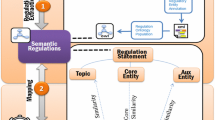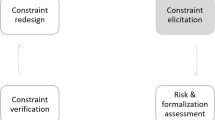Abstract
Implementing regulatory documents is a recurring, mostly manual and time-consuming task for companies. To establish and ensure regulatory compliance, constraints need to be extracted from the documents and integrated into process models capturing existing operational practices. Since regulatory documents and processes are subject to frequent change, the constant comparison between both is mandatory. Additionally, new regulations must be integrated and checked against existing process models. To address these challenges, we provide an approach that uses natural language processing to automatically support compliance assessment between regulatory documents and process model repositories. The outcome is a pairwise matching between parts of a regulatory document and process models from a repository. This matching can be used to either determine the coverage of regulations by a process model or to guide compliance assessment by ranking models based on their fitness and cost. The approach is implemented and applied in two real-world case studies: one from the energy domain and the other based on the General Data Protection Regulation.
Access this chapter
Tax calculation will be finalised at checkout
Purchases are for personal use only
Similar content being viewed by others
Notes
- 1.
- 2.
The identifiers (R1 to R3) have been inserted for clarity.
- 3.
- 4.
- 5.
Due to limited space within the figures and since the values for AP and MAP are lower than for \(\gamma =0.8\) the results for \(\gamma =0.9\) are omitted.
- 6.
Article 29 has one of the highest fitness scores for almost each of the process models since this article just consists of one single constraint, i.e., the chance of having a high semantic similarity with one obligatory activity from a process model is high.
References
van der Aa, H., Di Ciccio, C., Leopold, H., Reijers, H.A.: Extracting declarative process models from natural language. In: Giorgini, P., Weber, B. (eds.) CAiSE 2019. LNCS, vol. 11483, pp. 365–382. Springer, Cham (2019). https://doi.org/10.1007/978-3-030-21290-2_23
Van der Aa, H., Leopold, H., Reijers, H.A.: Comparing textual descriptions to process models-the automatic detection of inconsistencies. Inf. Syst. 64, 447–460 (2017)
Van der Aa, H., Leopold, H., Reijers, H.A.: Checking process compliance against natural language specifications using behavioral spaces. Inf. Syst. 78, 83–95 (2018)
Agostinelli, S., Maggi, F.M., Marrella, A., Sapio, F.: Achieving GDPR compliance of BPMN process models. In: Cappiello, C., Ruiz, M. (eds.) Information Systems Engineering in Responsible Information Systems. CAiSE 2019. Lecture Notes in Business Information Processing, vol. 350. Springer, Cham (2019). https://doi.org/10.1007/978-3-030-21297-1_2
Bajwa, I.S., Lee, M.G., Bordbar, B.: SBVR business rules generation from natural language specification. In: AAAI Spring Symposium, pp. 2–8 (2011)
Böhmer, K., et al.: Application and testing of business processes in the energy domain. Big Data Management Systems in Business and Industrial Applications (2017)
Dragoni, M., Villata, S., Rizzi, W., Governatori, G.: Combining NLP approaches for rule extraction from legal documents. In: MIREL (2016)
Friedrich, F., Mendling, J., Puhlmann, F.: Process model generation from natural language text. In: Mouratidis, H., Rolland, C. (eds.) CAiSE 2011. LNCS, vol. 6741, pp. 482–496. Springer, Heidelberg (2011). https://doi.org/10.1007/978-3-642-21640-4_36
Ghose, A., Koliadis, G., Chueng, A.: Process discovery from model and text artefacts. In: Services, pp. 167–174 (2007)
Hashmi, M., Governatori, G.: Norms modeling constructs of business process compliance management frameworks: a conceptual evaluation. Artif. Intell. Law 26(3), 251–305 (2017). https://doi.org/10.1007/s10506-017-9215-8
Hashmi, M., Governatori, G., Lam, H.-P., Wynn, M.T.: Are we done with business process compliance: state of the art and challenges ahead. Knowl. Inf. Syst. 57(1), 79–133 (2018). https://doi.org/10.1007/s10115-017-1142-1
Honnibal, M., Montani, I.: spaCy 2: natural language understanding with Bloom embeddings, convolutional neural networks and incremental parsing (2017)
Kharbili, M.E., Medeiros, A.K.A.D., Stein, S., van der Aalst, W.M.: Business process compliance checking: current state and future challenges. In: MobIS (2008)
Meth, H., Brhel, M., Maedche, A.: The state of the art in automated requirements elicitation. Inf. Softw. Technol. 55(10), 1695–1709 (2013)
Omg, O., Parida, R., Mahapatra, S.: Business process model and notation (BPMN) version 2.0. Object Manag. Group 1 (2011)
Rinderle-Ma, S., Kabicher-Fuchs, S.: An indexing technique for compliance checking and maintenance in large process and rule repositories. EMISAJ 11, 1–24 (2016)
Sànchez-Ferreres, J., van der Aa, H., Carmona, J., Padró, L.: Aligning textual and model-based process descriptions. Data Knowl. Eng. 118, 25–40 (2018)
Schröder, G., Thiele, M., Lehner, W.: Setting goals and choosing metrics for recommender system evaluations. In: UCERSTI2 (2011)
Selway, M., Grossmann, G., Mayer, W., Stumptner, M.: Formalising natural language specifications using a cognitive linguistic/configuration based approach. Inf. Syst. 54, 191–208 (2015)
Sinha, A., Paradkar, A.: Use cases to process specifications in business process modeling notation. In: Web Services, pp. 473–480 (2010)
Winter, K., Rinderle-Ma, S.: Deriving and combining mixed graphs from regulatory documents based on constraint relations. In: Giorgini, P., Weber, B. (eds.) CAiSE 2019. LNCS, vol. 11483, pp. 430–445. Springer, Cham (2019). https://doi.org/10.1007/978-3-030-21290-2_27
Author information
Authors and Affiliations
Corresponding author
Editor information
Editors and Affiliations
Rights and permissions
Copyright information
© 2020 Springer Nature Switzerland AG
About this paper
Cite this paper
Winter, K., van der Aa, H., Rinderle-Ma, S., Weidlich, M. (2020). Assessing the Compliance of Business Process Models with Regulatory Documents. In: Dobbie, G., Frank, U., Kappel, G., Liddle, S.W., Mayr, H.C. (eds) Conceptual Modeling. ER 2020. Lecture Notes in Computer Science(), vol 12400. Springer, Cham. https://doi.org/10.1007/978-3-030-62522-1_14
Download citation
DOI: https://doi.org/10.1007/978-3-030-62522-1_14
Published:
Publisher Name: Springer, Cham
Print ISBN: 978-3-030-62521-4
Online ISBN: 978-3-030-62522-1
eBook Packages: Computer ScienceComputer Science (R0)




